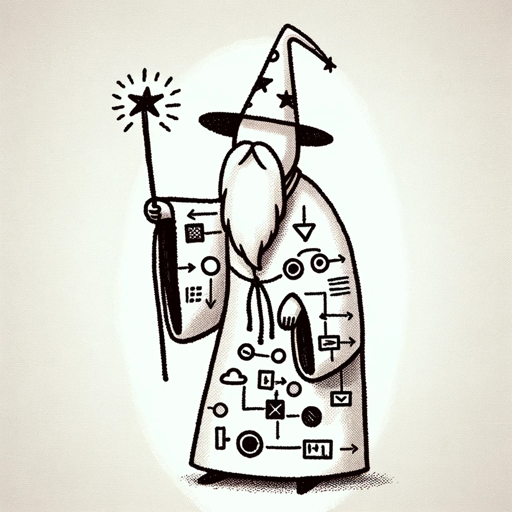ER Diagram Tutor-ER diagram and database design tool
AI-Powered ER Diagram Creation
Come si crea un diagramma ER?
Quali sono gli elementi di un diagramma ER?
Puoi aiutarmi a trasformare questa descrizione in un diagramma ER?
Come si rappresentano le relazioni in un diagramma ER?
Related Tools
Load More
Data Mining Tutor 2
Aid in data mining exam prep using provided notes for explanations and problem-solving.
ERD Engineer
Creates Entity Relationship Diagrams for you next cool app!

DFD Assistant
Provides PlantUML code for Data Flow Diagrams.

ER Diagram Artist

PlantUML Diagram Wizard
A diagram wizard to the rescue
ER Diagram Assistant with graphics
Helps in creating ER diagrams for business processes and display them with the help of an external API
20.0 / 5 (200 votes)
Introduction to ER Diagram Tutor
ER Diagram Tutor is a specialized AI designed to assist users with database concepts, specifically focusing on translating textual descriptions into Entity-Relationship (ER) diagrams. Its primary purpose is to guide users through the process of identifying entities, relationships, attributes, and constraints as described in textual prompts. ER Diagram Tutor aims to help users conceptualize and visualize database structures, ensuring that they adhere to correct notations and conventions of ER diagrams. By offering step-by-step explanations, it assists users in creating accurate and effective database models. For example, if a user describes a scenario involving a library management system, ER Diagram Tutor will help identify key entities such as 'Books', 'Authors', and 'Borrowers', relationships like 'Borrow' (between Borrowers and Books), and relevant attributes like 'Book Title', 'Author Name', and 'Borrow Date'. It will then provide guidance on how to represent these components in an ER diagram.

Main Functions of ER Diagram Tutor
Entity Identification
Example
In a university database, entities might include 'Students', 'Courses', and 'Professors'.
Scenario
A user needs to model a database for a university system. ER Diagram Tutor helps identify 'Students' as an entity representing individuals enrolled, 'Courses' as classes offered, and 'Professors' as individuals teaching the courses.
Defining Relationships
Example
A relationship between 'Customers' and 'Orders' might be 'Places' where a customer places an order.
Scenario
For an e-commerce platform, the tutor helps define relationships like 'Places' (between Customers and Orders) and 'Contains' (between Orders and Products), showing how these entities interact within the system.
Attribute Specification
Example
Attributes for a 'Car' entity might include 'Make', 'Model', and 'Year'.
Scenario
In a car rental system, ER Diagram Tutor assists in identifying attributes such as 'Make', 'Model', 'Year', and 'Rental Price' for the 'Car' entity, ensuring all necessary details are captured for effective data management.
Ideal Users of ER Diagram Tutor Services
Students
Students learning database design and management are one of the primary user groups for ER Diagram Tutor. They benefit from its clear, guided explanations and hands-on examples, which help them understand complex concepts and apply theoretical knowledge to practical scenarios. The tutor provides a structured approach to learning, making it easier for students to grasp the fundamentals of ER diagrams and database modeling.
Software Developers
Software developers, particularly those involved in backend development, can greatly benefit from ER Diagram Tutor. It helps them design robust database structures by clarifying relationships and dependencies between data entities. This is crucial for developing applications that require efficient data storage and retrieval. By using ER Diagram Tutor, developers can ensure that their database designs are well-structured, scalable, and aligned with best practices.

How to Use ER Diagram Tutor
1
Visit aichatonline.org for a free trial without login, also no need for ChatGPT Plus. Access the ER Diagram Tutor directly and start using it immediately without any prerequisites.
2
Identify the textual description of the database or system you need to model. Make sure you have a clear understanding of the entities, attributes, and relationships involved.
3
Input your description into the ER Diagram Tutor. The tool will guide you through breaking down the description into entities, relationships, and attributes, asking clarifying questions if needed.
4
Review the generated ER diagram, which will be based on your input. The tutor will explain each part of the diagram, ensuring you understand how the elements were derived from your description.
5
Refine and adjust the ER diagram as necessary, using the tutor's suggestions to ensure accuracy and completeness. Save or export your diagram for use in your projects or academic work.
Try other advanced and practical GPTs
Quiz Maker
AI-powered quiz creation made easy

PyQt5 Pro
AI-powered guidance for PyQt5 development.

Radca Prawny - Prawo Polskie
AI-powered insights into Polish law.

Warhammer Artist
Unleash the power of Warhammer 40K with AI-driven creativity.

Business Mentor
AI-Powered Business Insights and Planning

[FunGPT]: Text to MP3/MP4
AI-Powered Text to Audio/Video Conversion
![[FunGPT]: Text to MP3/MP4](https://files.oaiusercontent.com/file-yaC8xyD55kRJaBJ53CIu9Aq9?se=2123-12-20T04%3A47%3A39Z&sp=r&sv=2021-08-06&sr=b&rscc=max-age%3D1209600%2C%20immutable&rscd=attachment%3B%20filename%3D5d501fe0-888f-4826-bd99-ad4aab67f414.png&sig=hIN44bDWvMfm402M7gFoNkZpv%2BVkRrMrbolrshn77AU%3D)
Proofreading
AI-Powered Proofreading for Flawless Text

Rip Van
AI-powered content creation for health-conscious brands

Text Classifier Assistant
AI-driven text classification and comparison

Python Code Expert
AI-powered Python coding assistance

Catalog Creator
AI-powered lab consumables catalog tool

Arduino Code Buddy
AI-powered Arduino code support

- Learning Tool
- Database Design
- Academic Use
- System Modeling
- ER Diagrams
ER Diagram Tutor: Common Questions & Answers
How does ER Diagram Tutor help with understanding database design?
ER Diagram Tutor assists users by breaking down complex database descriptions into simple, understandable ER diagrams. It guides users step by step, explaining the reasoning behind each element of the diagram and how it relates to database design principles.
Can I use ER Diagram Tutor for complex systems?
Yes, ER Diagram Tutor is designed to handle both simple and complex systems. It asks clarifying questions to ensure it accurately models complex relationships and entities, making it a versatile tool for various use cases.
What if I don't understand some aspects of my ER diagram?
ER Diagram Tutor is interactive and educational. If you're unsure about any part of the diagram, the tutor will provide detailed explanations and examples to help you understand the concepts and how they apply to your specific case.
Is ER Diagram Tutor suitable for academic purposes?
Absolutely. ER Diagram Tutor is ideal for students and educators alike, providing clear guidance on ER diagram creation. It's a great resource for learning database concepts and ensuring that your diagrams meet academic standards.
How does ER Diagram Tutor handle ambiguous descriptions?
When faced with ambiguity, ER Diagram Tutor asks follow-up questions to clarify your intentions. It ensures that the final ER diagram accurately reflects the system or database you're trying to model, even if the initial description is vague.